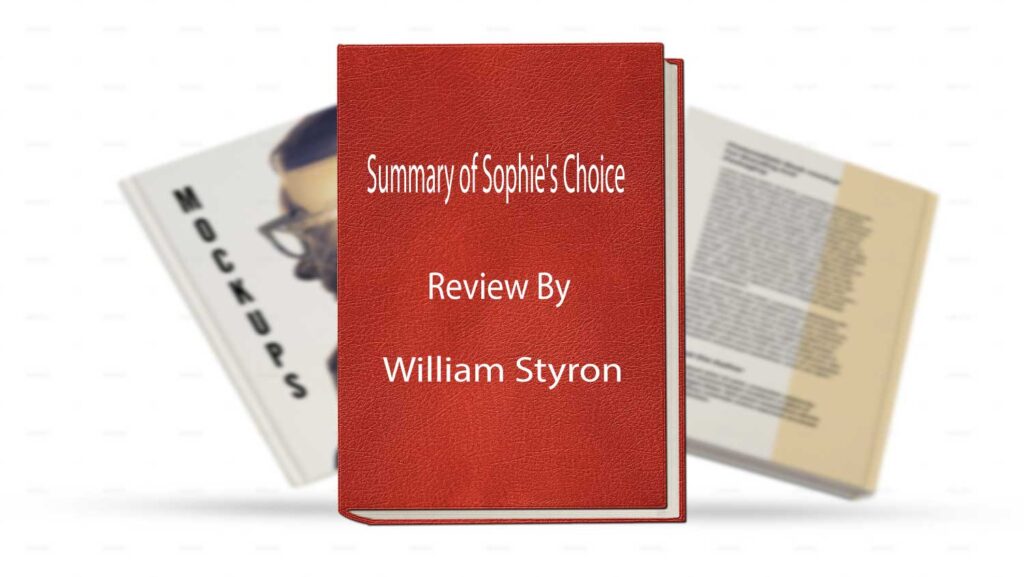Sophie’s Choice by William Styron is a compelling and haunting exploration of the human psyche in the aftermath of World War II. Set in Brooklyn, the novel follows Stingo, a young Southern writer, as he becomes acquainted with Sophie, a Polish immigrant haunted by her past. The heart of the story lies in Sophie’s devastating choice in a Nazi concentration camp, which continues to torment her long after the war has ended. As Stingo delves deeper into Sophie’s tragic history, he grapples with themes of trauma, guilt, and the complexities of moral responsibility. Styron’s prose is both lyrical and evocative, capturing the pain and anguish of Sophie’s past while also shedding light on the resilience of the human spirit. Summary of Sophie’s Choice is a masterful work of literature that challenges readers to confront the darkest depths of human experience while also finding hope amidst the wreckage of the past.
Summary of Sophie’s Choice
Introduction: William Styron’s Sophie’s Choice is a profound and haunting masterpiece that delves into the depths of human experience in the aftermath of World War II. Through intricate storytelling and rich character development, Styron crafts a narrative that is both emotionally gripping and intellectually stimulating. In this detailed review, we will explore the themes, characters, and narrative techniques that make Sophie’s Choice a timeless and unforgettable work of literature.
Themes: At the heart of Sophie’s Choice are several profound and interrelated themes that resonate deeply with readers. One of the central themes is the exploration of trauma and its enduring impact on the human psyche. Sophie, the titular character, is haunted by her experiences during the Holocaust, particularly the harrowing choice she was forced to make in a Nazi concentration camp. Styron skillfully portrays the psychological toll of Sophie’s trauma, depicting her struggle to come to terms with her past and find a sense of redemption.
Another prominent theme in the novel is the nature of guilt and moral responsibility. Through the character of Stingo, the narrator, Styron grapples with questions of complicity and culpability in the face of historical atrocities. Stingo’s interactions with Sophie and her lover, Nathan, force him to confront his own moral shortcomings and the complexities of human nature. Styron’s exploration of guilt is nuanced and thought-provoking, challenging readers to reconsider their own ethical convictions and judgments.
Summary of Sophie’s Choice explores the complexities of love and friendship in the face of adversity. The relationship between Sophie, Stingo, and Nathan is fraught with tension, passion, and betrayal, reflecting the tumultuous emotions of post-war America. Styron captures the intricacies of human connection with sensitivity and depth, portraying the highs and lows of friendship and romance with honesty and authenticity.
Characters: The characters in Sophie’s Choice are richly drawn and deeply human, each contributing to the complexity and depth of the narrative. Sophie, with her tragic past and haunted demeanor, is a particularly compelling protagonist. Styron masterfully portrays her inner turmoil and emotional fragility, evoking empathy and sympathy from readers. Sophie’s struggle to reconcile her past with her present is a poignant and powerful journey that forms the emotional core of the novel. Stingo, the narrator and protagonist, serves as the reader’s guide through the story, offering insight and perspective on the events unfolding around him. His southern charm and naive idealism provide a stark contrast to the darkness and despair that permeate Sophie’s world. Stingo’s journey of self-discovery and moral awakening mirrors the larger themes of the novel as he grapples with his own demons and shortcomings.
Sophie’s enigmatic lover is a complex and volatile character whose presence looms large over the narrative. Styron deftly captures Nathan’s charisma and charm, as well as his darker impulses and insecurities. Nathan’s descent into madness and violence serves as a chilling reminder of the fragility of the human mind and the destructive power of unchecked emotions.
Narrative Techniques: Styron employs a variety of narrative techniques to bring The Summary of Sophie’s Choice to life, immersing readers in the sights, sounds, and sensations of post-war America. One of the most notable techniques is the use of first-person narration, with Stingo serving as the storyteller and guide. Through Stingo’s perspective, readers gain intimate access to his thoughts, emotions, and memories, forging a deep connection with the protagonist and his journey.
Styron’s prose is lyrical, evocative, and richly descriptive, transporting readers to the streets of Brooklyn and the beaches of the South with vivid imagery and sensory detail. The novel’s setting serves as a backdrop for the character’s inner turmoil and external conflicts, reflecting the broader social and cultural upheavals of the post-war era. In addition to first-person narration, Styron intersperses the narrative with flashbacks and reminiscences, offering glimpses into Sophie’s past and the events that shaped her. These moments of retrospection add depth and complexity to the story, illuminating the motivations and desires of the characters while also deepening the novel’s thematic resonance.
Also Read: I am Malala PDF by Malala Yusuf Jaai Review
What are the weaknesses of this book?
Sophie’s Choice by William Styron is widely acclaimed for its powerful storytelling and profound exploration of human nature, but it is not without its weaknesses. One notable weakness is the novel’s length and pacing. At over 600 pages, the narrative can feel overly dense and slow-moving at times, with lengthy passages of introspection and exposition that may test the patience of some readers. Styron’s writing style, while lyrical and evocative, can be verbose and indulgent, with an abundance of descriptive detail that may detract from the overall momentum of the story.
Some readers have criticized the novel for its portrayal of Sophie, the titular character. The summary of Sophie’s Choice is undeniably complex and compelling; her characterization has been subject to scrutiny for its reliance on certain stereotypes and tropes, particularly those related to her status as a Holocaust survivor. Critics argue that Sophie’s trauma is often sensationalized and romanticized, reducing her to a symbol of suffering rather than a fully realized individual with agency and autonomy.
Sophie’s Choice has been criticized for its portrayal of mental illness, particularly in the character of Nathan. While Styron’s depiction of Nathan’s descent into madness is undeniably harrowing and affecting, some readers have raised concerns about the novel’s stigmatizing portrayal of mental illness as inherently violent and dangerous. This portrayal perpetuates harmful stereotypes and misconceptions about mental health, contributing to the marginalization and discrimination of individuals living with mental illness.
Despite these weaknesses, Sophie’s Choice remains a profound and thought-provoking work of literature that continues to resonate with readers for its exploration of trauma, guilt, and the complexities of human nature. However, it is important for readers to approach the novel critically and with an awareness of its limitations, particularly in its portrayal of sensitive and potentially triggering subject matter.

Sophie’s Choice book age rating: suitable ages of readers
Sophie’s Choice Review by William Styron is generally recommended for mature readers due to its complex themes, graphic content, and mature subject matter. While there is no official age rating for books like there is for movies or video games, it’s commonly suggested for readers ages 18 and older.
The novel contains explicit descriptions of violence, including scenes depicting the horrors of the Holocaust, which may not be suitable for younger or more sensitive readers. Additionally, the book explores heavy themes such as trauma, guilt, mental illness, and sexuality, which require a certain level of emotional maturity and critical thinking to fully grasp and process. Sophie’s Choice contains adult language and scenes of a sexual nature, which may not be appropriate for younger readers or those who are uncomfortable with explicit content. Parents and guardians should use their discretion and consider the individual maturity and sensitivities of younger readers before allowing them to read Sophie’s Choice. It may be helpful for adults to read the book first and assess whether its content is suitable for younger readers.
How could the writer make this book more interesting?
To make Sophie’s Choice more interesting, the writer could further develop the secondary characters, providing deeper insights into their motivations, backgrounds, and relationships with Sophie and Stingo. By fleshing out the supporting cast, the author could add complexity and depth to the narrative, enhancing the reader’s understanding of the central characters and their interactions. The writer could incorporate more suspenseful elements into the plot, introducing twists, turns, and unexpected revelations to keep readers engaged and guessing. By building tension and intrigue, the author could create a more dynamic and compelling storyline that captures the reader’s attention from start to finish. The writer could explore alternative narrative structures or perspectives, such as shifting between different characters’ points of view or incorporating flashback sequences, to offer fresh insights into the story and its themes. By experimenting with narrative techniques, the author could deepen the emotional impact of the novel and offer readers a more immersive reading experience. Sophie’s Choice Review: By focusing on character development, plot twists, and narrative innovation, the writer could make Sophie’s Choice even more captivating and memorable for readers.
Why is this book so popular in the 20th century?
Sophie’s Choice Plot Summary gained popularity in the 20th century for several reasons. Its exploration of complex and weighty themes such as trauma, guilt, and the Holocaust resonated with readers grappling with the aftermath of World War II. The novel’s vivid portrayal of Sophie’s harrowing experiences and her morally impossible choice struck a chord with audiences, prompting introspection and discussion about the nature of human suffering and resilience. William Styron’s lyrical prose and meticulous attention to detail captivated readers, drawing them into the richly textured world of post-war Brooklyn and the inner lives of its characters. Sophie’s Choice received critical acclaim and literary awards, cementing its reputation as a seminal work of 20th-century literature. Its success was further amplified by adaptations into other mediums, including film, which introduced the story to wider audiences and solidified its place in popular culture. Sophie’s Choice Book Summary achieved popularity in the 20th century due to its compelling narrative, powerful themes, and the enduring resonance of its characters and story.
Purchase This Book From Amazon
Should this book be worth reading now, in 2024?
Sophie’s Choice Book Summary by William Styron remains a timeless and relevant work of literature that is worth reading in 2024. Despite being published in the 20th century, the novel continues to resonate with contemporary readers due to its exploration of universal themes such as trauma, guilt, and the complexities of human relationships. The moral dilemmas faced by the characters, particularly Sophie’s impossible choice in a Nazi concentration camp, provoke thought and discussion about the nature of morality and the human condition. Additionally, Styron’s masterful prose and rich characterizations offer readers a compelling and immersive reading experience that transcends historical and cultural boundaries. Sophie’s Choice Book Synopsis serves as a poignant reminder of the enduring legacy of World War II and the Holocaust, prompting reflection on the lessons of history and the importance of bearing witness to the atrocities of the past. Sophie’s Choice remains a powerful and thought-provoking novel that continues to captivate and inspire readers in 2024 and beyond.
Conclusion: Summary of Sophie’s Choice
Sophie’s Choice Novel Summary by William Styron stands as a timeless masterpiece that delves deep into the complexities of human nature and the lasting scars of history. Through vivid prose and rich characterizations, Styron crafts a narrative that resonates with readers, offering profound insights into themes of trauma, guilt, and the nature of moral responsibility. The novel’s haunting portrayal of Sophie’s impossible choice and its aftermath serves as a powerful reminder of the horrors of the Holocaust and the resilience of the human spirit. Styron’s exploration of love, friendship, and betrayal adds depth and complexity to the story, drawing readers into the tangled web of emotions that binds the characters together. Sophie’s Choice Synopsis is a compelling and thought-provoking work of literature that continues to captivate readers with its timeless themes and enduring relevance.













This Post Has One Comment